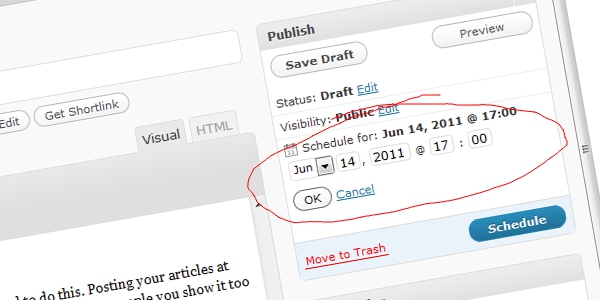Knowing how to write amazing content can be difficult, but it is vitally important for your website. It is easy for your visitors to go elsewhere for better content if you are not delivering what they want.
Every time you write a new article you should ask yourself “Would I read this?“. If the answer is no, then you need to go about changing it. This could be as simple as adding a few good quality images, editing your grammar or changing the title – perhaps more.
You should spend time making all your articles or blog posts excellent because these will help your website. The better the post, the more people will read it. The more people that read it and like it, the more people will share it with their friends. All this is great for you because it increases both your reputation and, more importantly, traffic to your website! The more traffic you get, the more money you can earn!
So, I thought I’d write this 10 step guide to help you improve your articles. I hope you find this helpful.
1. Headline Title
The headline of your articles is vitally important. This is what interests people and catches their attention. The better the headline, the more likely people are to read the article or click on the link to your website.
Headline writing can be a bit of an art form. You need to keep it reasonably short, whilst clearly stating what the article is about and making it sound appealing. This can be more difficult for certain subjects, but a good headline can be written for anything, you just need to be a bit creative!
For example, you may have a lengthy article about different diets and food regimes that can aid weight loss, which discusses which is the most suitable for you. Writing the headline ‘Different diets and food regimes that can aid weight loss, which discusses which is the most suitable for you‘ is terrible! No one is likely to read that, it sounds boring, however with a bit of thought ‘Best weight loss diets for you‘ is much better. It is shorter, gets to the point and a bit more enticing.
A very popular trend at the moment is ‘Top Lists‘. People love reading Top 10, Top 5, Top 100 lists about anything. Readers can see instantly how long the article is likely to be and are interested to see what you have chosen to be number one on your list. Using the previous example, ‘Top 5 weight-loss diets‘ instantly jumps up and grabs the reader. This type of headline is great, but it does require you to structure your articles in a certain way.
So, before you post your article, put a bit of thought into your headline. It could be the difference between someone choosing to read your article or not!
Check out our ‘How To Write Great Headlines‘ post for more tips on title writing.
2. Write Something That People Want To Read
This may sound obvious, but a lot of people don’t do this. It’s all well and good you writing a brilliant article about your local village park, but if no one is going to read it then what’s the point! To write a successful blog, you need to write for your audience. The bigger the audience you write for, the more people will read it.
Another thing that people often do is start writing off topic. If you are writing a blog about cars, don’t start writing about bicycles. You may find some people that are interested, but more likely this will just confuse your targeted audience. Try to stay on topic!
3. Make Your Blog Posts Easy To Read
Whatever your articles are about, they need to be easy to read. If people, for what ever reason, struggle to read your content then they will simply leave and go elsewhere. A good example of this is what font you choose to write in. Choosing a fancy font may well look good, but if it makes reading harder, then you are just creating problems for yourself.
The way you structure your articles can also make a big difference. Writing big chunks of information in giant paragraphs can put a lot of people off. Try to break your information up into smaller more manageable paragraphs or bullet points. Big, bold titles and sub-titles can also help to break up your articles and make it easier for people to find what they are looking for.
Spelling and Grammar!!! There is no excuse for spelling mistakes and poor grammar in my view. Spell checkers should eliminate 99% of all your mistakes and bad grammar can usually be rectified by simply re-reading your article. I get annoyed when people use bad grammar because it gives the impression that the writer couldn’t be bothered to re-read his own post, so why should I bother to read it myself! Not only that, but it makes the article seem rushed, that not too much thought has been put into what is being said. Everybody makes mistakes, but consistent mistakes are bad for business!
4. Consistency
Consistency in your writing can make you appear more professional. These can be little things such as;
- Using the same styling for links,
- Using the same image sizes,
- Structuring your articles in a similar way, etc.
Websites that vary in such things can appear a bit amateurish, which may put some people off your website and seek a more professional site.
This may seem excessive, admittedly this isn’t the most important point on the list, but I do believe that putting that extra bit of effort into making sure that everything is perfect pays off in the long run.
5. Images
“A picture speaks a thousand words!”
You can use images within your articles to help explain things easier, whilst making them more visually appealing to your readers. Having large amounts of text can be boring and off putting, so by adding a simple image, this can help attract more readers.
These images don’t even need to be that relevant (though it helps), they just help to brighten up and make it more visually appealing.
Check out our post on ‘How To Use Images In Your Blog Posts‘ and learn about properly optimizing your images for more helpful tips.
6. Linking
Everybody places links within their text these days, but there is a right way and a wrong way to do this. One of the biggest challenges of running your own website is attracting traffic, so it is counter-productive to place links that instantly take people away from your site! Instead, you can simply make your outbound links open in a new window/tab (taget=”_blank”), that way when people click on them, they still have your site open. This is particularly useful when linking to affiliate products or other websites.
Many people often forget that they can link to their own products/articles within their own text. This is a great way of directing traffic around your website. People who may have stumbled upon your website will be able to quickly link between your pages, showing them how good your site is. These internal links can open within the same window because it is your own website.
Controlling your traffic in this type of way is what I like to call, making your website “Waterproof“. When people come to your website, you need to keep them there! They need to be able to navigate through your website easily, or close the website completely. Any links that take traffic directly to another website is ‘leaky’ traffic! This ‘leaky’ traffic needs to be plugged so that you are not loosing traffic because traffic equals money!
7. Article Length
I’ll admit that I have mixed opinions about article length Generally, most people advise that shorter posts are much better than lengthy articles because people find them easier to read and it takes less time. It is true that articles that are in excess of 2500-3000 words are less read than shorter ones, however I do believe that if you offer quality information that helps an individual, like a tutorial, then a longer post is more suitable. As long as a long article is made to look more appealing and broken up into small segments that are easy to read, readers will be willing to read them. I think a good rule to remember is not to make articles longer than they have to be. Try editing your articles down after writing your initial draft to cut down on excess.
Articles that are broken up into several separate posts generally annoy people. There is nothing more frustrating than spending time reading an article and then finding that at the end it continues next week! If you are going to write an informative post, then put it into a single post, otherwise you risk annoying traffic away.
8. SEO Friendly
It is important to remember when writing your articles to make them search engine friendly. This is done by including certain key words within your text that search engines identify and help rank you well in searches. This doesn’t need to be excessive, remember that you are writing for the reader first, not the search engine!
Meta tags and Meta descriptions can also help improve your search engine rankings. In WordPress, you can add tags (meta tags) to each blog post. Using keywords that are related to your content help the search engines identify what your article is about, therefore helping your ranking. The higher you can rank on google/bing/yahoo searches, the more traffic you will get.
Read more about SEO and learn the difference between On-Page SEO & Off-Page SEO techniques.
9. When to Publish
The majority of people post their articles as soon as they are ready, I myself used to do this. Posting your articles at certain times can increase traffic to your site. It is all about getting people to see it, so the more people you show it too at the same time, the more likely it is that people will click on it to read it.
This method only really works when you have an email list for your site. You can send them automated updates telling them to check out your latest post. The best times to send these are usually during the week, Monday to Thursday between 2-6pm GMT. Why between 2-6pm GMT? Well this is because Europe is finishing work and America is starting to wake up. You have a large amount of potential traffic that you could get to your site. The weekend usually sees a drop in traffic, probably because people go off and do things on their days off.
Of course, these times are dependant on the content of your website. If your site is aimed at the Japanese, then you will want to post at a time when they are most likely to read it!
If you haven’t tried doing this before, then give it a try. It may surprise you!
10. Repetition is bad
Repetition is bad! 🙂 If you write an article on a specific subject, make sure that your next post is about something a bit different. This is just common sense really. A reader is less likely to come back to your site and read an article that you wrote a similar one on a few days ago. I do this myself with this website, tending to write on different category topics when I can.
There is nothing wrong with having similar content from a certain subject, as long as you make it individual and original from your other posts.
Did you find this post helpful? What tips do you use to write amazing content? What do you like about other website content that makes them stand out? Please leave your comments below & feel free to ask any questions.




CommentLuv vs Disqus – Why I Don’t Use CommentLuv!